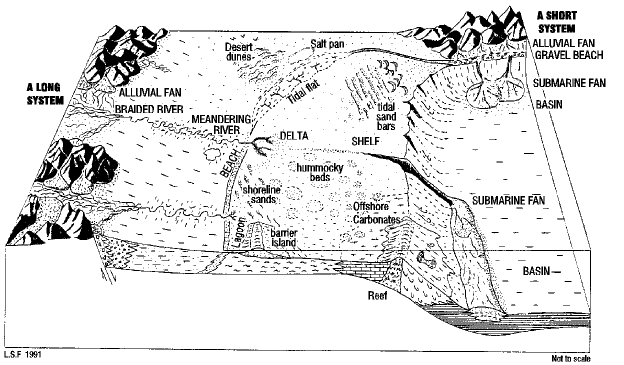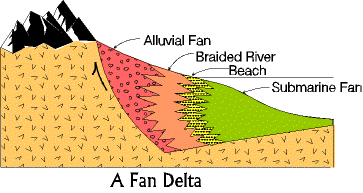
 pdf version - (What is pdf?)
pdf version - (What is pdf?)Simplistically the earth's surface is divided into two broad divisions: (1) Sourcelands - areas which are sources of sediment, usually meaning mountainous regions, but including any place erosion and sediment removal takes place, and (2) Depositional Basins - areas which receive eroded sediment. We are interested in both sourcelands and depositional basins, but depositional basins are our primary interest here.
Depositional basins are subdivided a number of ways. One is by the predominant sediment type found in the basin; thus, Siliciclastic Dominated Systems and Carbonate Dominated Systems.
Carbonate dominated systems occur in tectonically stable regions where the supply of siliciclastic sediment is minimal or non-existent. Most of the remaining discussion is for siliciclastic dominated systems.
A second way of partitioning depositional basins is into terrestrial, transitional (shoreline and nearshore), and marine (epicontinental sea to deep water ocean basins) divisions.
A third way of dividing depositional basins is into depositional environments. All these divisions are interrelated, but depositional environments are the primary discussion here.
Depositional Environments
A depositional environment is a portion of the earth's surface characterized by a unique combination of physical, chemical, and biological processes. These processes control how sediment is transported and deposited, what chemical modification it undergoes, and what kind of organisms live in and affect the sediment. The processes result in the characteristic and distinctive sedimentary deposits typical of each environment by which we recognize and identify them.
Classification of Environments by Depositional Processes |
||
Terrestrial |
Transitional |
Marine |
|
Alluvial Fan Braided River Meandering River (including alluvial plain) Lake |
Delta Complex Beach Lagoon Tidal Flat Dunes |
Shelf (storm and tidal dominated) Submarine fan Basin |
| Tidal Flat Lagoon |
Carbonate Barrier (reef) Shelf Basin |
|
Several dozen depositional environments have been identified. The more common ones are listed in the table above. Most environments you will find familiar, although you have probably not thought of them from a process point of view. Of the many depositional environments known, a smaller number are of special importance because they cover large portions of the earth's surface, or are common in the rock record. It is this smaller number of environments we explore here.
| OBSERVE: In everyday speech we talk of a beach, for example, as a place we can go visit, and our language encourages us to think of environments as places. You will probably have to remind yourself that in geology depositional environments are defined by processes. |
Systematic Changes From Sourceland to Depositional Basin
Depositional environments are not distributed randomly or haphazardly. Each exists in a specific location for specific reasons. A general observation we can make is: sediment changes from the sourceland to the depositional basin such that depositional environments evolve in systematic and predictable sequences from sourceland to depositional basin. In general, depositional environments and thus rock types are predictable from sourceland to depositional basin.
For example, large siliciclastic particles dominate near the sourceland in alluvial fans and braided rivers, and fine siliciclastic particles dominate at the end of the sequence in ocean basins far away from the sourceland. An ideal downstream sequence of environments is illustrated on the Siliciclastic Depositional Systems model at the top of the page.
Long Systems
The complete sequence of depositional environments from mountain to ocean basis is what we call a "long system". The sediments at the beginning of long systems are chemically and mechanically unstable in composition, and are generally poorly sorted, immature gravels. Within the ideal long system the distance or time of final deposition from sourceland to basin is great. Thus, by the end of the long system the sediments are chemically and mechanically stable in composition, and are well sorted into the end member sizes of sand and clay. Sandstones at the end of the long system are mature quartz arenites.
Although complete long systems are found, many variations on the model occur, usually because environments are missing from the sequence. There is one inviolate observation, however:
OBSERVATION: Individual environments can be missing from the ideal long sequence, but the overall sequence of environments is never rearranged so that a downstream environment comes before an upstream one.
Short Systems
 " Short systems" are environmental sequences in which only a few environments from the ideal long sequence are present. Short system environmental sequences are abbreviated because, unlike the long system, the siliciclastic sourceland is proximal to (close to) the basin. Sediments across the entire system are chemically and texturally immature. They are generally poorly sorted and range in size from gravel to coarse sand.
" Short systems" are environmental sequences in which only a few environments from the ideal long sequence are present. Short system environmental sequences are abbreviated because, unlike the long system, the siliciclastic sourceland is proximal to (close to) the basin. Sediments across the entire system are chemically and texturally immature. They are generally poorly sorted and range in size from gravel to coarse sand. Short systems are commonly observed in tectonically active regions. Depending on circumstances, virtually any of the environments from the long system can be missing. For example, in the Basin and Range province of the western United States large alluvial fans form at the base of fault block mountains and everything else downstream from the mountains is missing; a very short system.
One type of short system is common enough it has a special name - Fan Delta. Fan deltas form where high mountains stand abruptly out of the sea, such as in rift valleys (see Wilson Cycle Stage B), or next to subduction-created volcanic arcs (see Wilson Cycle Stage E), or next to the thrust belt terrain (see Wilson Cycle Stage F). A typical sequence of depositional environments in a fan delta is alluvial fan and/or braided-river to a gravel beach to a submarine fan to a basin.
Carbonate Systems
Carbonate systems develop where siliciclastic sourcelands are low and/or very distant, the water is shallow, and climates are tropical to subtropical. In the warm, clear, shallow water calcareous algae flourish and generate micrite, while invertebrate animal skeletons accumulate as sedimentary particles (bioclasts). The oolitic, pelletal, and intraclastic allochems are also produced locally, depending on conditions.
It is not unusual for carbonates to be generated distally in long and short siliciclastic systems. Under these conditions, however, the volume of siliciclastic sediment usually overwhelms the carbonates. The major exception is extreme distal shelves of both long and short systems where the siliciclastic sediment does not reach.
Carbonate systems are, of course, not going to have terrestrial environments (unless we include supertidal flats). Transitional and marine environments dominate. Carbonate environments are modeled as "belts" running parallel tothe coastline. The full model has 9 environmental belts, but here it is simplified to five: tidal flat, lagoon, reef, shelf, and basin (see carbonate depositional environments).